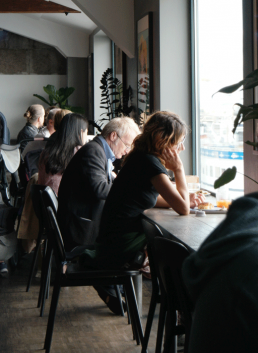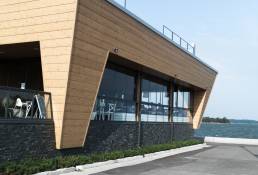DESIGN // ART & WELL-BEING
10. October 2021FEATURED,INTERIOR,ART
art and wellness
It’s almost instinctive to associate art with wellbeing and healing, and it’s easy to suppose that art’s impact on wellbeing is simply aesthetic. Art does have a powerful impact on an environment and, by extension, on our experience of that environment. It can humanise a harsh, clinical hospital hallway or enliven a dull office, emphasising the human and social functions of sterile or functional environments. Humanising and beautifying an environment has the effect of reducing anxiety and depression while improving general happiness and productivity – even serving for some as an inspiration for meditation or quasi-religious psychic renewal.
So, art and wellness go hand in hand. There is growing scientific evidence that proves art can enhance brain function. It has an impact on our emotions, brain wave patterns, the nervous system and can actually raise serotonin levels which make us feel happier. This fast pace that we all are living, it is very important to stop and enjoy just a moment painting and do nothing else.
When we observe a profound piece of art, we are potentially firing the same neurons as the artist did when they created it, thus making new neural pathways and stimulating a state of inspiration. This sense of being drawn into a painting is called “embodied cognition” says writer J. Devsney.
Former editor R. Smith of BMJ also made a very interesting point – ‘if health is about adaptation, understanding and acceptance, then the arts may be more potent than anything that medicine has to offer’.
"Art holds out the promise of inner wholeness."
— Alain de Botton, writer

art gives purpose
Art can change our outlook and the way we experience the world. It can raise the spirits and strengthen the soul, it can help us make sense of our surroundings and change us and our society for the better.
Our wellbeing is first and foremost dependent on our emotional and mental state. Thus, creating interiors which support our overall wellbeing must include artwork that reflects the issues the inhabitant can understand and relate to. We can survive reasonably well in an interior that has no art, but it brings purpose, meaning and adds value to one’s life.
Including artwork in interior design doesn’t mean we have to spend considerable sums of money. We can easily find affordable pieces or art in a local market or side street, how much a piece costs should not define its’ real value to you. Digitalisation also allows many artists to publish print versions of their paintings that can be printed on either watercolour or canvas. I think it’s a great way to start bringing art into your home and doesn’t require a big budget.

art is therapeutic
The strongest link between art and wellness is of course in therapy. Philosopher Alain de Botton explains very distinctly how art benefits individuals and is often used as therapy:
- Helps with memory by seeing something as it is instead of receiving too much information all at once
- Makes us appreciate situations and life, by looking at what we already have which in turn increases our feeling of happiness.
- Deals with feelings of sadness and sorrow
- Gives us balance and perspective
- Guides us to grow by assisting in self-knowledge which help us be better people
We believe art should start a conversation rather than dull it, conflicting opinions on art should be celebrated not avoided. If we have an emotional response to a piece of art then it is a success! Perhaps the meaning of art and wellness is that it’s there to support us in our feelings and to help us rediscover our sense of self.
As you can see, artwork is more than just a painting or photography hanging on the wall. It is closely connected to our well-being and has a constant effect on us. Were you aware of this? Now it’s your turn: place art in your surroundings that is pleasant for you and learn to appreciate its positive effect on your body and mind. Have fun!
Looking for more art in Scandinavian style? Then definitely check out my Pinterest board “Art I love”!
Love,

STOCKHOLM // CAFE VETEKATTEN
3. September 2021NORDIC LIVING
19. September 2021
STOCKHOLM // VETEKATTEN











Photography @Piritta Sillan
DESIGN // NATURAL FIBRES
Our skin is by far the body’s largest organ. So, it goes without saying that protecting and treating it well is very important and that extends to all of it, not just the small percentage on our face. From clothes, to bedsheets to towels, our skin is impacted by the natural fiber choices we make.
Even if you do not have sensitive skin, we recommend reading through this blog. It is lengthy but absolutely rammed with useful information that I guarantee will impact your next purchase. So bear with me.
Knowing where and what to look for in matters of sustainable materials can be quite empowering. I made you a little spreadsheet, so you can take a screenshot to your phone and the next time you are shopping, first take a quick peek to check which fibers is worth buying.
skin friendly natural fibers
Alpaca
Believe it or not, alpaca wool is one of the most ethical products currently available that is completely eco-friendly and cruelty-free at the same time. They’re not killed for their wool, but caught by the farmers and gently sheared. This is why many vegans wear alpaca wool products. Alpaca fibre and wool does not contain fat or allergenic lanoline, so no strong chemicals are needed to clean it. This makes it an environmentally friendly fibre too!
Cashmere
One of the rarest and most luxurious fibres in the world. This exceptionally silky material is said to be three times as warm as wool and is known to be long-lasting. Cashmere doesn’t come from sheep, but from goats! It is a natural fabric, though there are huge environmental and social impacts arising from this material. In short, it takes 4 goats to make 1 cashmere jumper as opposed to 5 jumpers being made from 1 sheep… it’s easy to do the maths. It’s so bad that ASOS has band cashmere and mohair from its site! My recommendation is to buy recycled or reused cashmere.
Cotton (made organically)
A natural fibre that is capable of quick biodegrading once discarded, cotton is a classic and useful material. Unfortunately, conventionally grown cotton requires a significant amount of water to grow and like many crops uses an abundance of harsh pesticides and insecticides. Choosing organic cotton will not solve the water issue though does help to reduce the negative impacts of pesticides on our environment.
Hemp
Hemp is a dense plant that requires no pesticides or herbicides to keep it healthy. The material is made from long fibrous strands that when spun together create a thread that can be used to weave hemp fabric. It is one of the few agricultural products that can feed us, clothe us, house us and be used for medicinal purposes.
Jute (a very coarse fibre used for carpets / rugs)
Jute fibres exhibit naturally anti-static, insulating and moisture-regulating properties, perfect for layering on a wooden floor. Jute is also highly durable, resilient material, making it ideal for heavy-traffic areas like the living room, as well as a great investment. What’s more, natural rugs are perfect for the eco-conscious consumer of today. Jute in particular is a highly sustainable, rapidly renewable resource. It is currently the most eco-friendly, biodegradable and recyclable natural material in the world!
Linen (made from flax)
Another easily biodegradable plant based fibre, Linen is made using the entire flax plant and is often combined with cotton to create a fully biodegradable and soft textile. The flax plant requires much less water for its cultivation than cotton, making it an eco-friendlier option.
Modal
Similar to Tencel this fibre is made from spinning cellulose from beechwood trees. Because beechwood trees self-rejuvenate they are considered a sustainable raw material. Modal is 50% more water-absorbent than cotton and is silky smooth making good choice of activewear and undergarments manufacturers.
Sisal (a very coarse fibre used for carpets / rugs)
Sisal is an environmentally friendly fibre as it is biodegradable and almost no pesticides or fertilisers are used in its cultivation. It is extracted from the leaves of an Agave plant. Due to its high durability, a rug made of sisal is great for areas in your home with a high foot fall such as hallways.
Silk (or peace silk)
Not only is it timelessly elegant, silk also has flame retardant and antibacterial properties. Traditional silk is made from the cocoons of silkworms. As the cocoons are harvested before the silkworms have emerged from their cocoons, silk manufacturers will kill the silkworms with gas or steam before collecting the cocoons.
According to PETA, 3,000 silkworms are killed to make every 500 grams of silk! Peace silk alternatively is woven by hand by fair trade producers in India. This cruelty-free silk is sourced from the cocoons of the wild Eri moth. The process does not involve touching or harming the moths, nor does it require keeping them in captivity. Rather their cocoons are collected from the forest after the moths emerge and fly away.
Tencel
The material comes from eucalyptus trees which require no harmful pesticides or insecticides to grow. Eucalyptus trees also require significantly less land and water, when compared to something like cotton. The process of actually manufacturing the Tencel yarn by Australian company Lenzing is fuelled with 100% renewable energy.
Wool
It’s obviously an animal byproduct, meaning many vegans avoid it like the plague! But it is a great renewable resource with plenty of benefits. Once a woollen garment has been worn out, you can literally just bury it in the ground, and it will eventually compost. Wool is a breathable and a natural insulator and has a unique ability to react to changes in the body’s temperature. Once you know to only use cold water, wool is easy to care for! When buying wool, look for standards and certifications that ensure the fair treatment of animals and the respect of the environment, such as the Responsible Wool Standard, ZQ Merino Standard and the Soil Association Organic Standards.
man-made fibers
You could say that man-made synthetic fibers are plastic fabric because they are chemically-derived fibres which are joined together to create a fabric. This is a process called polymerization and it requires several chemicals and solvents to create any type of synthetic fabric. Which is definitely not a good product for our health.
According to BodyEcology.com, below are the big hitters in man-made fabrics and the harsh chemicals that go into producing them. Remember, all these chemicals are leaching into our skin and waterways every time we wear and wash our clothes.
Polyester
Is the worst fabric you can buy. It is made from synthetic polymers that are made from esters of dihydric alcohol and terpthalic acid.
Acrylic fabrics
Are polycrylonitriles and may cause cancer, according to EPA.
Rayon
Is recycled wood pulp that must be treated with chemicals like caustic soda, ammonia, acetone and sulphuric acid to survive regular washing and wearing.
Acetate and Triacetate
Are made from wood fibres called cellulose and undergo extensive chemical processing to produce the finished product.
Nylon
Is made from petroleum and is often given a permanent chemical finish that can be harmful.
Fabrics treated with PFC chemicals
Anything static resistant, stain resistant, permanent press, wrinkle-free, stain proof or moth repellent. Many of the stain resistant and wrinkle-free fabrics are treated with perfluorinated chemicals (PFCs), like Teflon.
Bamboo
Lastly, Bamboo fabric may seem like a natural fibre but it is produced more like a synthetic fabric. This is why you should probably avoid it. Bamboo fibres are extremely stiff and rough and must undergo heavy processing with caustic chemicals in order to create a soft material. According to research conducted by a sustainable brand the process to convert bamboo to its softest state (rayon fibre) releases toxic chemicals (carbon disulphide, sodium hydroxide, and sulphuric acid) that are actually reproductive hazards.
natural fibers are less toxic than synthetic fibers
It’s clear to see that the choice to purchase natural fibre textiles not only reduces your toxic burden but also the toxic impact on the environment – 100% win-win!
When it comes to body care products and cosmetics, we all now know that what we put on our skin is absorbed into the bloodstream. So, it’s only natural to then assume that if textile fibers are treated with chemicals, our skin could absorb some of those chemicals as well.
While we need more research to understand how toxic fibers can affect our health, we do understand the dangers of bad chemicals.
natural textile fibers are a better investment
I´m really keen to things that are meaningful and made to last. Have you ever noticed how well your natural fabrics hold up much longer than synthetic ones? Natural textiles always seem to last forever and stay in their beautiful shape. While on the other hand, synthetic fibers begin to break down and look tired more quickly.
Of course, natural fibres usually are more expensive up front, but in the long run, it’s a better investment for yourself and at the same time, a better investment for the environment!
natural textile fibers are more sustainable
Sustainability has changed from a trend to a need. So, when it comes to home textiles – natural fibre is generally more sustainable than synthetic fibres that require high energy use and crude oil. Additionally, natural fibres are plant materials and therefore decompose quickly. Synthetic fibres are essentially plastic, and so do not biodegrade quickly.
Some advantages of environmentally friendly products are:
Better health
Energy efficiency
Enhanced indoor air quality
Low maintenance
As you can see, natural materials have great benefits for your home. Therefore, just give them a try.
Here is the spreadsheet for you, which should help you for shopping natural materials. Have fun!
Best regards, Laura

DESIGN // NON-TOXIC FURNITURE
15. November 2019NORDIC LIVING
I love to keep my furniture for ages, so I get pretty excited when the time comes to bring something new into my home. I usually start my “furniture-hunt” at looking some interior magazines and Pinterest for inspiration and visiting all of my favorite showrooms to explore what is out there and all the possibilities that come with them. But it gets so hard when there are endless options out there and you want to make sure it’s just perfect for your home. My definition of perfect has changed over time and I’ve become more concerned with the health and safety and ethics of the products I purchase.
Before, I only cared about the look and the price. For my excuse, as a student, I couldn’t afford much anything else and quite frankly, didn´t had the patience to save up. Now that I´m getting older and wiser, my income is better, and I want my furniture to be good quality and non-toxic. I’m mostly drawn to wooden furniture, so I thought that would be fairly easy to find. But after some time I found that even natural materials can be glued, coated and treated with some pretty nasty stuff. After talking with few friends about it, I realised I´m not the only one with this problem how to find non-toxic furniture and differentiate from company’s so called “greenwashing”. my sense is that, industry-wide, sustainable furniture practices are advancing slowly despite the urgent need to transform almost every aspect of the furniture industry.
What is in it?
Sadly, I learned that most furniture are made with all sorts of harmful chemicals which I definitely wouldn’t want to bring into my home. It’s not nice to think that our indoor air quality is compromised by bringing in formaldehyde that can lurk in particle wood, or the glue vapours that are inside rugs, or the stain proof compounds that are sprayed on the couch and the list goes on. All of these nasties can easily turn our healthy sanctuary into a toxic minefield.
Basically, these tiny particles can float into the air we breathe and settle on the floor where our children and pets play. Without knowing it we inadvertently breathe the fumes, ingest the particles and absorb these contaminants into our skin.
These bad chemicals can give us headaches and rashes, make us drowsy and dizzy, they can also irritate our eyes, throat and lungs and trigger allergies. They also have been linked to messing with our hormones and contributing to a variety of serious health issues over time.
While it would be nearly impossible in today’s world to eliminate chemicals from our homes entirely, there are plenty of ways we can significantly reduce exposure. In this article, I’ll cover the common toxins to avoid in both new and second-hand furniture and the healthier, natural alternatives to choose in their place.

1. Go with Natural Materials
I can´t stress this enough. A good rule of thumb – stick to raw, natural materials when sourcing non-toxic furniture. When we think of natural furniture materials, we naturally think of wood. But, it’s important to note that pressed veneer is also made of wood but usually not a very healthy way. Pressed veneer is more than often glued together with a resin that’s made from formaldehyde. This is a dangerous toxin that is known to release into the air over time.
A good healthy alternative to pressed wood is furniture made from solid wood such as birch, teak, walnut, oak, or bamboo. You also need to make sure the wood is either untreated or that it’s finished with natural stains or paints, in place of solvent-based varnishes or other toxic coatings.
2. Peak in for Natural Fabric filling & Upholster
Choose fabrics made from natural textiles such as wool, cotton, and hemp — ideally grown without the use of pesticides and manufactured without harmful toxins. Upholstery made from polyester or nylon can cause itching and other unpleasantries. Try to avoid upholstery that has been treated for stain, moth, or fire resistance. Also furniture stuffed with synthetic foam, polystyrene, and other materials that are made with harmful petrochemicals. Natural non-toxic furniture alternatives include fillings made from cotton, kapok, natural latex and coconut coir.
3. Before use: Off-Gas Chemicals
If you do purchase furniture that’s made from synthetic materials or it’s coated with toxic solvents, be sure to off-gas them before use. Whenever you smell a product, it’s off-gassing. It happens the most when a product is new. Fresh paint? New memory foam smell? Off-gassing. This is especially important if there is any item that will be in your bedroom/ sleeping rooms! Of course everything off-gasses and pineapples and roses are off-gassing too. But some fumes are more toxic than others, and the chemicals from plastics and adhesives tend to be the worst.
It is best to unpack and leave these products outdoors while they off-gas. Otherwise, set them in the room you use the least and open the windows. Seal any vents you might have in the room and turn on a fan to better circulate the air. Then close the door behind you and put a towel under the door to keep the fumes from flowing back into the house.
4. My precious: Second-Hand Furniture
Natural materials can be more expensive than synthetics and like me back then as a student or because of the financially challenges throught the pandemie, non-toxic hardwood furniture or bamboo accessories might not be in the budget. If that’s the case, second-hand furniture is your way to go.
A good point about getting second-hand furniture is that you typically don’t have to be as concerned with the manufacturing materials, as you would with new furniture. This is because any chemical vapours would probably off-gas before making their way to your home.
However, that doesn’t mean these new-to-you items won’t smell musty, smoky, or otherwise funky. Vintage or reclaimed wooden furniture might be safe and healthy if you are sure it hasn’t been refinished recently with conventional products, and it has not been exposed to chemical cleaning products, smoke, mold, pesticides, or other chemical substances. And on the off-chance they don’t smell at all, it’s still a good idea to clean any second-hand items thoroughly before using them. Good tip is to use some white vinegar and baking soda. It will clean, disinfect, and deodorise most items well enough.
Take a look at outdoor furniture to be used inside.
The benefit here would be the simplicity of the design. Metal or solid wood as the base. Cushions that can be left outside to offgas or replaced with a cushion of your choice. Outdoor cushions are often made with either polyurethane or polyester fill and the covers can have waterproofing on them, but because of the ability to remove them from the sofa and offgas them, this could be a simple, affordable and healthy option for many.
Here are some non-toxic manufactures in Scandinavian style:
SWE: https://www.hastens.com/uk/mastery/materials
DN: https://materdesign.com/pages/ethics-sustainability
DN: https://www.skagerak.dk/de/about/about-us
FIN: https://nikari.fi/one-of-a-kind/
And here some news for IKEA-lovers: The standard IKEA sofas (i.e. not the futons) are made with particleboard, which offgasses some formaldehyde; regular polyester fabric not treated with perfluorinated chemicals (e.g. PFOS, PFOA, PFOSA); and polyurethane foam cushions which are low in offgassing and free of flame retardants.
The main difference between IKEA and the “greener” brands above is the use of particleboard. (Particle board, also known as chipboard, is an engineered wood product manufactured from wood chips or jute-stick chips and a synthetic resin or other suitable binder, which is pressed and extruded. Safety concerns exist for both manufacturing and use. Fine dust and chemicals are released when particleboard is machined (e.g., sawing or routing). Cutting particle board can release formaldehyde, carbon monoxide, hydrogen cyanide in the case of amino resins, and phenol in the case of phenol-formaldehyde resins. The other safety concern is the slow release of formaldehyde over time.)

But I feel you, finding non-toxic furniture that’s both healthy and beautiful can take a while and little extra effort, especially if you’re used to visiting the more commonly recognised shops. But believe me, the pay off in the end is absolutely worth it. Not only will your non-toxic furniture contribute to a healthier home and increase your wellbeing, you’ll be filling your space with unique one-off pieces that you will absolutely love, they´ll will be your “life-partners” and you are happy about it every time you see it. So improve your quality of life and say bye bye to fast consumption!
Next time you´re looking for new furniture, you can start with this list for the material you want to look and check for:
- Natural cushion fill such as natural latex, cotton, down, and wool.
- No chemical/formaldehyde treatments on the fabric (such as Scotch Guard and other stain and water-resistant coatings especially PFOAs).
- Eco Leather – Conventional leather is made with toxic dyes and treatments. Some folks may prefer leather due to the ability to wipe it down.
- Solid woods, not formaldehyde filled pressed wood products.
- Zero or low-VOC glues, stains, and varnishes
- Flame retardant free but the picks here are all FR free.
- Polyurethane does offgas at low levels, but I don’t rule it out completely. Make sure it is flame retardant free (“Soy Foam” is still polyurethane with some soy).
- GOTS certified fabrics and GOLS certified latex.
- For non-toxic zero-VOC tables, chairs, bookcases, benches and storage units look for solid wood (with zero-VOC stains and varnishes), and zero or low-VOC adhesives.
- Low odor woods are preferable for some sensitive people.
- Avoid laminated wood which has particle board or MDF board. Plywood is not as high in offgassing as MDF or particle board.
- There are some formaldehyde-free pressed wood products like Purebond plywood (though some sensitive folks react to that proprietary glue).
- Some types of furniture are more likely to have a veneer of real wood glued on to a lower quality wood. In some styles this is hard to avoid.
HELSINKI // LÖYLY
11. May 2019TRAVELScandinavian,Finland,löyly,nordic living,Helsinki
11.May 2019
HELSINKI // LÖYLY
Extravaganza finnish sauna Löyly in Helsinki – great tip for your summer holiday in the north and for lovers of modern architecture! The sauna for a new generation – Löyly – looks simply ingenious! An absolute architectural eye-catcher and definitely worth a visit! I could sit on the terraces for hours, stare at the sea and enjoy the relaxed atmosphere. Sauna culture is an important part of Finnish culture and national identity. As the sense of community becomes an increasingly important aspect of the new city culture, the idea of the city of Helsinki to offer foreign visitors a year-round public sauna experience was born. Already the landscape is simply unique. Löyly is located in the former industrial area of Hernesaari, which is being developed into a residential area. Although it is located in the Finnish archipelago, it is less than two kilometres from the city centre.



A finnish sauna Löyly in Helsinki – the result of a special ecological project
Here is everything thought out down to the smallest detail: the sculptural structure made of heat-treated pine offers visual privacy, but the slats do not obstruct the view of the sea from the interior, but function as blinds and protect against views from outside. There are sheltered outdoor spaces between the warm mass and the shell, where you can cool down between sauna sessions. The staggered shell also forms a staircase to the roof and viewing terraces on top of the building. The structure forms a large outdoor auditorium for the future activities of the water sports centre. The large wooden terrace floats partly above the sea and you can hear the sound of the waves under your feet. The future appearance is also not left to chance: If the wood turns grey over time, it should resemble the rocks of the coast.
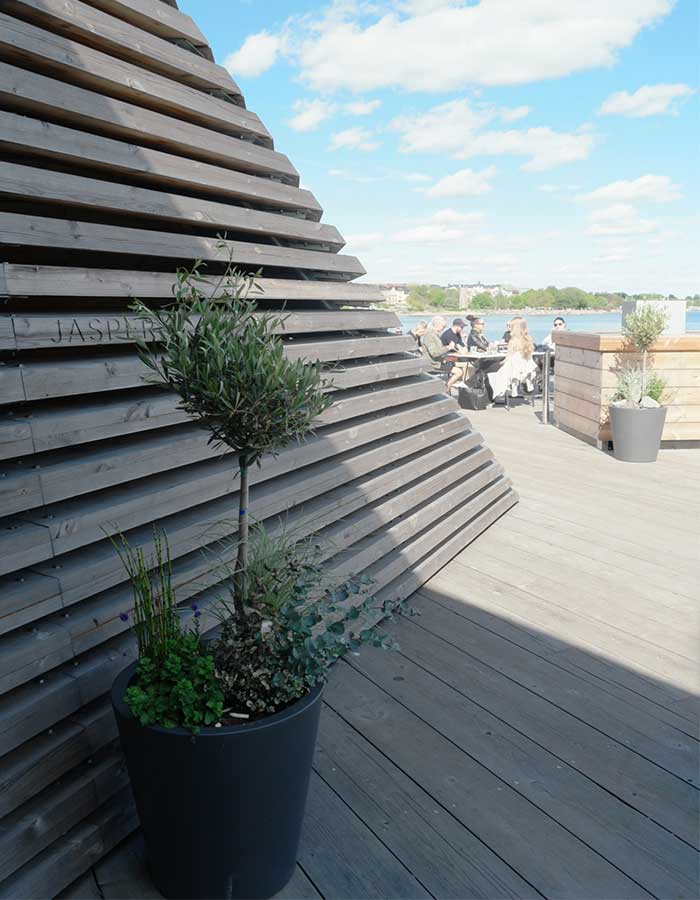

Two parts of Löyly
The building consists of two parts: a public sauna and a restaurant. There are three different saunas, all heated with wood: a continuously heated sauna, a uniquely heated sauna and a traditional smoke sauna – a real rarity in urban saunas. The atmosphere is quiet and the rooms are dimly lit. The ideology of “green business” is evident everywhere: the restaurant serves organic dishes and fish from sustainable stocks. The building is the first in Finland and the second in Scandinavia with FSC certification, which confirms that the wood comes from sustainable forests. The building is heated by district heating and electricity is generated by water and wind power.


The interior design is more gently minimalist and thus appears very elegant and modern, a typical Scandinavian style of furnishing. The main materials in the interiors are black concrete, light Scandinavian birch wood, blackened steel and wool. The birch wood used is pressed, glued and lightly heat-treated, a new and sustainable Finnish innovation made from plywood industry material remnants that are normally incinerated for energy production. This transforms the remains into a beautiful recycled material.
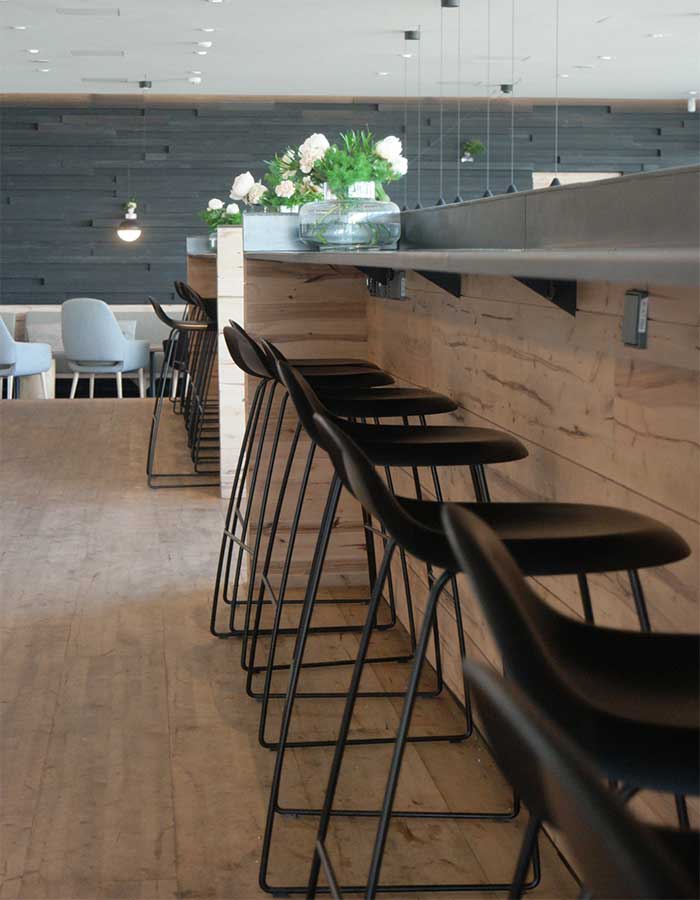

I also found some comments about finnish sauna Löyly in Helsinki (source: Tripadvisor):
“Great ambience, very clean, sometimes perhaps hot for beginners to get used to. But a mega ambience. The Finns are not as devoutly quiet as we Central Europeans. You are allowed to talk and enjoy yourself in the sauna. The jump into the sea, a shock. But I’ve rarely felt so good about it. Be sure to try it! Tickets must be booked online with a time window. Everything top” – Carolina
“I visited Löyly with colleagues on a cold and foggy Finnish summer evening. The design of the sauna is incredible and takes the traditional Finnish sauna to a new level. We especially liked the cooling in the sea at + 8 degrees.” Franca
“Modern design and spacious. Bar and restaurant right outside the door – the food was really incredible, ordered the traditional Finnish soup and burgers”. –Diana
So, next time you visit Helsinki, try löyly. You ´ll love it, I promise. More information can be found here.

Photography @Piritta Sillan
STOCKHOLM // CAFE´S
5. May 2019TRAVELDesign,Sweden,stockholm,food,cafés,travel
05.May 2019
STOCKHOLM // CAFE´S
Did you know, that Swedes are some of the world’s biggest coffee drinkers. Yeah, Café culture is huge in Sweden. Many cafés will stay open until the early hours & the Swedes make Fika (coffee breaks) a regular part of their day. To your next visit in Stockholm, here some tops spots where to take the traditional Swedish coffee break, fika and places with lunch offers. All with a typical reduced style and relaxed Scandinavian feeling.
1. Café Fabrique – special bread
This café specialises in a wide range of bread and you can also order your favourite bread – for a weekend brunch, for example. They have many varieties of rye bread, Levain, Danish rye bread, loaf of Gotland, spelled bread and besides the really great breads there are also great looking pastries. There are several factory branches in Stockholm, so many routes should include a detour and one or two delicacies!
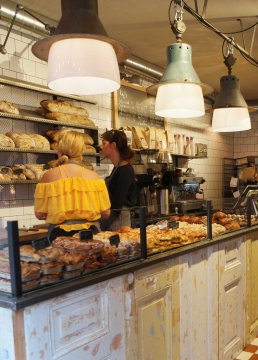

2. Haymarket- coffee drinking or staying overnight in the 1920s
One of the trendiest places to go and have a “fika” in all of Stockholm. The legendary PUB department store has gradually developed into a hotel. Haymarket by Scandic appreciates the tradition and the hotel is lovingly kept in the style of the 1920s. The cocktail bar in the spirit of Art Deco inspires with its details and the prevailing atmosphere and the café “Gretas” next door is a tribute to Greta Garbo, who worked in the department store before her career as a film star. Here the Stockholmers meet for a glass of wine. It is also worth mentioning that you cannot pay in cash at the café. Only EC and credit cards are accepted. In the hotel rooms there is a charm of the good old days, spiced up with all the amenities of today. (Hötorget 13-15.)



3. Green Rabbit
Celebrated chefs Mathias Dahlgren and Martin Berg are behind this innovative bakery, where organic ingredients and sustainability are front and center. In addition to bread and baked goods, the Green Rabbit bakery offers breakfast, Swedish varieties of Danish smørrebrød sandwiches and soup for lunch. Playfulness and curiosity set the standard, with great results for both the eyes and the taste buds. Swedish bread culture is nurtured here, while the food experience is spread to a broader audience.




4. Markthalle – Swedish lunch
There are good restaurants for lunch in the Östermalmer Markthalle. The old market hall is currently being renovated and therefore the traders were accommodated in a spacious room right next to the construction site until next summer. The modern interim solution, although only a temporary solution, is really atmospheric and chic. It’s worth stopping by here! (Östermalmstorg)




Photography © Piritta Sillan
GOTHENBURG // HOTEL FLORA
14. August 2018TRAVEL,INTERIOR
09.August 2018
GOTHENBURG // HOTEL FLORA







Photography @Piritta Sillan
















